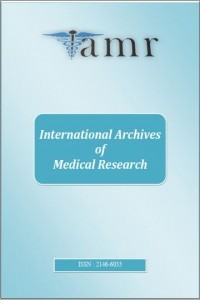Rotavirus and Enteric Adenovirus Detection Among Diarrheic Outpatients in a Tertiary Hospital
Rotavirus and Enteric Adenovirus Detection Among Diarrheic Outpatients in a Tertiary Hospital
Rotavirus, Enteric Adenovirus,
___
- 1. Chow CM, Leung AK, Hon KL. Acute gastroenteritis: from guidelines to real life. Clin Exp Gastroenterol 2010;3:97–112.
- 2. Rodriguez-Baez N, O’Brien R, Qiu S-Q, Bass DM. Astrovirus, Adenovirus, and Rotavirus in Hospitalized Childr... : Journal of Pediatric Gastroenterology and Nutrition. J Pediatr Gastroenterol Nutr 2002;35(1):64–68.
- 3. Winn WJ, Allen S, Janda W, et al. Diagnosis of Infections Caused by Viruses, Chlamydia, Rickettsia and Related Organisms [Internet]. In: Koneman’s Color Atlas and Textbook of Diagnostic Microbiology . Baltimore: Lippincott Williams &Wilkins; 2006. p. 1338.
- 4. Bresee J, Fang Z-Y, Wang B, et al. First report from the Asian Rotavirus Surveillance Network. Emerg Infect Dis 2004;10(6):988–995.
- 5. Parashar UD, Gibson CJ, Bresee JS, Glass RI. Rotavirus and severe childhood diarrhea. Emerg Infect Dis 2006;12(2):304–306.
- 6. Parashar UD, Hummelman EG, Bresee JS, Miller MA, Glass RI. Global Illness and Deaths Caused by Rotavirus Disease in hildren. Emerg Infect Dis 2003;9(5):565–572.
- 7. Tayeb HT, Balkhy HH, Aljuhani SM, Elbanyan E, Alalola S, Alshaalan M. Increased prevalence of rotavirus among children associated gastroen teritis in Riyadh Saudi Arabia. Virol J2011;8(1):548.
- 8. Arnold A, MacMahon E. Adenovirus infections. In: LK P, editor. Medicine (United Kingdom). 2017. p. 777–780.
- 9. Winn WJ, Allen S, Janda W, et al. Clinical Manifestations of Viral Infections. In: Koneman’s Color Atlas and Textbook of Diagnostic Microbiology. Baltimore: Lippincott Williams &Wilkins; 2006. p. 1349.
- 10. Ramsay M, Brown D. Epidemiology of group A rotaviruses. In: Gray J, Desselberger U, editors. Rotaviruses : methods and protocols. Totowa: Humana Press; 2000. p. 217–236.
- 11. Roman E, Wilhelmi I, Colomina J, et al. Acute viral gastroenteritis: proportion and clinical relevance of multiple infections in Spanish children. J Med Microbiol 2003;52(5):435–440.
- 12. Sánchez-Fauquier A, Montero V, Moreno S, et al. Human rotavirus G9 and G3 as major cause of diarrhea in hospitalized children, Spain. Emerg Infect Dis 2006;12(10):1536–1541.
- 13. Temu A, Kamugisha E, Mwizamholya DL, Hokororo A, Seni J, Mshana SE. Prevalence and factors associated with Group A rotavirus infection among children with acute diarrhea in Mwanza, Tanzania. J Infect Dev Ctries 2012;6(6):508–515.
- 14. González GG, Liprandi F, Ludert JE. Molecular epidemiology of enteric viruses in children with sporadic gastroenteritis in Valencia, Venezuela. J Med Virol 2011;83(11):1972–1982.
- 15. Tüzüner U, Saran Gülcen B, Özdemir M, Feyzioğlu B. Gastroenteritli Çocukların Dışkılarında Adenovirus ve Rotavirus Sıklığı ve Mevsimsel Dağılımı Frequency of Adenovirus and Rotavirus and Their Seasonal Distribution in Children With Gastroenteritis. Klimik Derg 2016;29(3):121–124.
- 16. Gül M, Garrpardiç M, Çiraggl P, et al. 0-5 Yaş Arası Gastroenteritli Çocuklarda Rotavirus ve Adenovirus Tip 40/41 Araştırılması. ANKEM Derg 2005;19(2):64–67.
- 17. Biçer S, Tunca Ahin G, Koncay B, et al. Incidence assessment of rotavirus and adenovirus associated acute gastroenteritis cases in early childhood Incidenza di gastroenterite acuta da rotavirus e adenovirus nella prima infanzia. Le Infez Med 2011;2:113–119.
- 18. Rad AY, Gözalan A. Detection of rotavirus and enteric adenovirus antigens in outpatients with gastroenteritis. Türkiye Klin tıp Bilim Derg 2010;30(1):174–179.
- 19. Bayraktar B, Toksoy B, Bulut E. Akut Gastroenteritli Çocuklarda Rotavirus ve Adenovirus Saptanması Detection of Rotavirus and Adenovirus in Children with Acute Gastroenteritis. Klimik Derg 2010;23(1):15–17.
- 20. Oh D-Y, Gaedicke G, Schreier E. Viral agents of acute gastroenteritis in German children: Prevalence and molecular diversi ty. J Med Virol 2003;71(1):82–93
- ISSN: 2146-6033
- Yayın Aralığı: Yılda 2 Sayı
- Başlangıç: 2011
- Yayıncı: Veysi AKPOLAT
A Renal Cell Carcinoma Case Presented w ith Spinal Cord Compression
Zuhat URAKCİ, Ogur KARHAN, Senar EBİNC, Nadiye AKDENİZ, Yasin SEZGİN, Mehmet KUCUKONER, Muhammet Ali KAPLAN, Abdurrahman İSİKDOGAN
Effects on Physical and Strength Parameters of Sports of Different Sports Branches
Ercan TİZAR, Savaş AYHAN, Süreyya Yonca SEZER, Gönül Rezzan TİZAR, Veysi AKPOLAT
Rotavirus and Enteric Adenovirus Detection Among Diarrheic Outpatients in a Tertiary Hospital
Fatih ÇAKIR, Nida ÖZCAN, Halil İbrahim ŞAHİN, Alican BİLDEN, Nezahat AKPOLAT, Selahattin ATMACA, Kadri GÜL
Mixed Ger m Cell Testis Tumor Presenting w ith Massive Lung Metastasis
Zuhat URAKCİ, Senar EBİNC, Ogur KARHAN, Yasin SEZGİN, Nadiye AKDENİZ, Mehmet KUCUKONER, Muhammet Ali KAPLAN, Abdurrahman İSİKDOGAN
